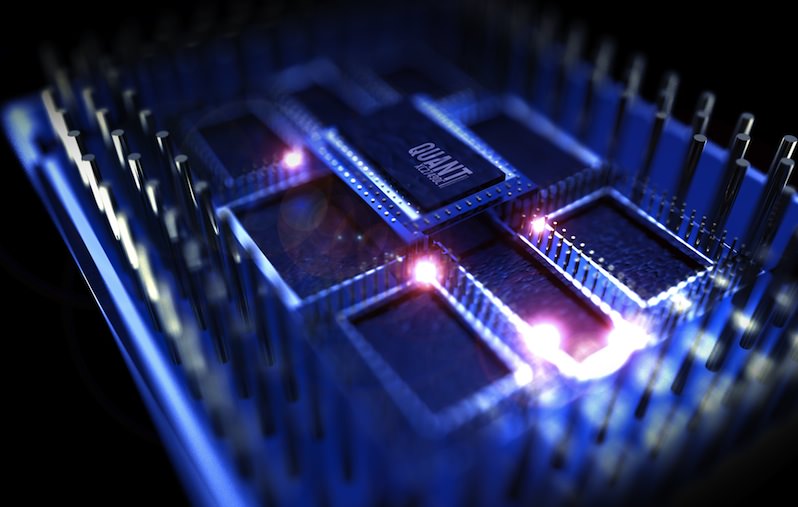Quantum Computers Are Coming, and Here’s How to Process That Information
There are potential positives and negatives in this equation. Shutterstock
Shutterstock
A quantum computer is a theoretical device that can be difficult to understand. The computer on which you’re likely reading this now operates using strings of 1’s and 0’s in its code. A quantum computer, on the other hand, could take advantage of the unusual properties of quantum bits, or qubits, which allows each bit to have a value of both numbers at the same time. The qubits change from a quantum state to a standard 1 or 0 when the correct answer to a problem has been figured out. The advantage of this model is that a quantum computer could be faster and more efficient, since it’s operating in a way that doesn’t rely on defined, singular numbers for coding.
An Australian research team from the University of South Wales has successfully created two kinds of qubits that achieve an operational accuracy of over 99 percent. Accuracy in performing operations is a huge factor in quantum computing research, as researchers need to maintain a success rate of at least 99 percent for the calculation to be reliable. In their video announcing their successes, the University of South Wales researchers contend that they have achieved high accuracy with natural phosphorus atoms and artificial silicon, respectively. The phosphorus atom reached a level of 99.9 percent accuracy, or one error for every 10,000 quantum operations, as they explain in the video.
“The whole point of quantum computer is we want to get a speed-up. We want to be able to show we can solve problems more efficiently than we can on classical computers,” Daniel Lidar, director and co-founding member of the University of Southern California Center for Quantum Information Science and Technology, told Truthdig. He says these successful experiments are an “important milestone” in the process of building an operational quantum computer, but he said we’re still “a ways off from building a useful device.”
Lidar says that once you can get these qubits to operate at a success rate of at least 99 percent, you can “bootstrap and you can build an arbitrarily large-scale device from the imperfect, but nearly perfect, components.” We’re not ready for that yet, though, he added. In addition to being able to ensure that singular qubits maintain accuracy while performing operations, developers also need to monitor qubits that are strung together in a quantum device. Lidar said “noise” between qubits could be generated that could compromise accuracy through connection.
An existing device called the D-Wave Two, made by D-Wave Systems, uses what is called “quantum annealing” to operate like the desired quantum computer, but it’s not quite the same as what these experiments hope to create. The D-Wave essentially solves “optimization problems,” which means the “processor considers all possibilities simultaneously to determine the lowest energy required to form those relationships” when computing, according to Lidar. Essentially, it finds an efficient connection between two points, using over 500 qubits to do so — but it can serve only limited functions. The circuit board-based quantum computer these experiments are aiming for would create a machine that could serve a broad list of needs like our current personal computers do, but better. Lidar said components could theoretically be added to the D-Wave to make it serve the purpose of performing many different kinds of operations, but the company hasn’t produced anything like that yet.
So why might experiments like the one out of Australia interest the lay audience? There are potential positives and negatives in this equation. On the positive side, quantum computers would likely be able to simulate quantum mechanics very accurately, which is a challenge with which scientists currently struggle, Lidar explained. For example, if a pharmacologist wants to understand exactly how a drug interacts with a virus, there needs to be a clear construction of the quantum mechanics behind the interaction, otherwise it’s just an approximation.
A possible negative of quantum computers has to do with cryptography. As of now, our communication networks use what are called public-key systems, in which individual computers use a private algorithm that can decrypt a network’s public algorithm so a secure connection can be made. With current computers, it typically takes a long time to figure out the algorithms and form the connection, but a quantum computer could be so powerful that it could break the code almost instantaneously. Former NSA technical director Brian Snow told The Guardian on Oct. 14 that “within ten to twenty years from now, you could have a quantum computer at scale, large enough and healthy enough, to attack the trust mechanisms of the web.”
Snow says public-key systems could “fall to pieces,” and secure connections that protect people’s banking information or other private data that circulates on the Web could be broken. The Guardian notes that there are older forms of cryptography that might be more protected from such a device, but there may be ways around those too.
“In the next few years there’s probably going to be several successful implementations of quantum computing devices,” Lidar said, based on the experiments he’s been tracking. “The main challenge has to do with demonstrating that your components are sufficiently reliable and that you can bootstrap them into making an — essentially — perfectly reliable system,” he said. Lidar knows that’s going to take more than inducing a few qubits to maintain high levels of accuracy on their own. In the meantime, your online activities should be — mostly — secure.
Your support matters…Independent journalism is under threat and overshadowed by heavily funded mainstream media.
You can help level the playing field. Become a member.
Your tax-deductible contribution keeps us digging beneath the headlines to give you thought-provoking, investigative reporting and analysis that unearths what's really happening- without compromise.
Give today to support our courageous, independent journalists.






You need to be a supporter to comment.
There are currently no responses to this article.
Be the first to respond.